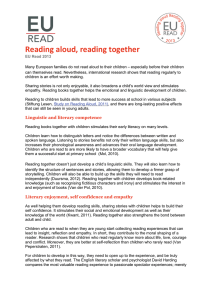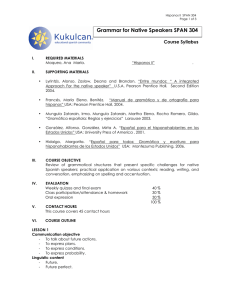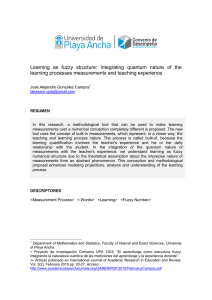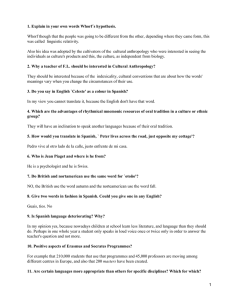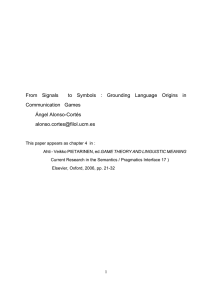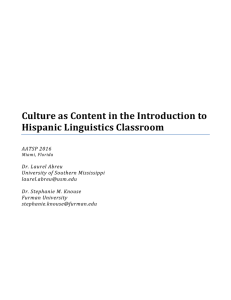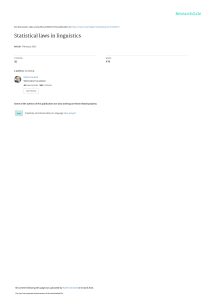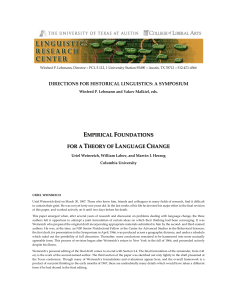A Model of Decision with Linguistic Knowledge 3
Anuncio
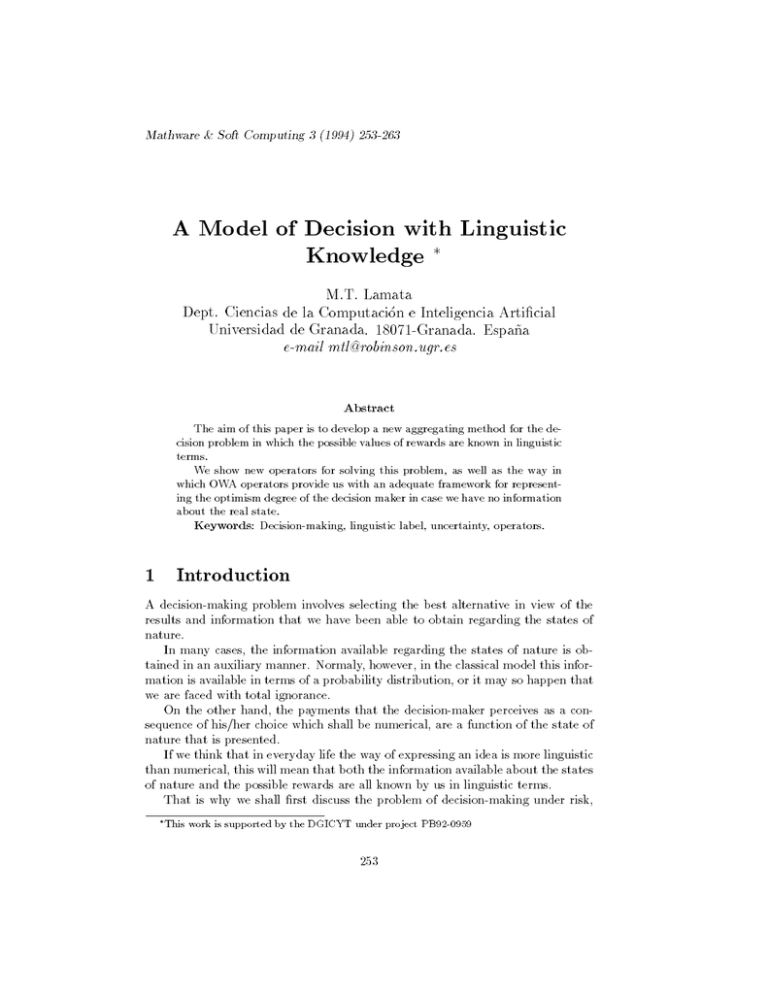
Mathware & Soft Computing 3 (1994) 253-263 A Model of Decision with Linguistic Knowledge 3 M.T. Lamata Dept. Ciencias de la Computacion e Inteligencia Articial Universidad de Granada. 18071-Granada. Espa~na e-mail mtl@robinson.ugr.es Abstract The aim of this paper is to develop a new aggregating method for the decision problem in which the possible values of rewards are known in linguistic terms. We show new operators for solving this problem, as well as the way in which OWA operators provide us with an adequate framework for representing the optimism degree of the decision maker in case we have no information about the real state. Keywords: Decision-making, linguistic label, uncertainty, operators. 1 Introduction A decision-making problem involves selecting the best alternative in view of the results and information that we have been able to obtain regarding the states of nature. In many cases, the information available regarding the states of nature is obtained in an auxiliary manner. Normaly, however, in the classical model this information is available in terms of a probability distribution, or it may so happen that we are faced with total ignorance. On the other hand, the payments that the decision-maker perceives as a consequence of his/her choice which shall be numerical, are a function of the state of nature that is presented. If we think that in everyday life the way of expressing an idea is more linguistic than numerical, this will mean that both the information available about the states of nature and the possible rewards are all known by us in linguistic terms. That is why we shall rst discuss the problem of decision-making under risk, 3 This work is supported by the DGICYT under project PB92-0959 253 M.T. Lamata 254 where the information about the states of nature is known in terms of a probability distribution, whereas the possible rewards are values expressed in linguistic terms. Finally, we shall deal with the case of decision-making under ignorance, where no information is available about the states of nature, and therefore in order to be able to act the decision-maker's attitude when faced with risk must be known. We shall solve the problem by introducing the OWA operators (Ordered Weighted Averaging), which oer us a more general framework than the one known till now. 2 The decision problem Let us consider a decision-making problem with the following elements: f ; D; r; I ; g where: 1. is the set of states of nature which we suppose are nite. 2. is the set of alternatives available to the decision-maker, among which the decision-maker must choose one. D 3. r: 2 ! is a function where a real number corresponds to every decision and to every state . D di R wj ( di ; !j ) 0! r( di ; !j ) rij With being the reward given to the decision-maker for having chosen the decision when the state has been presented r can be represented by a matrix called the Matrix of rewards. rij di wj D n 1 A2 A 1 11 r21 w r 2 12 r22 111 111 111 r j 1 r2j 111 111 111 r m 2 111 rij 111 rim 2 111 rnj 111 rnm w r 1 ri 1 rn Ai ri An rn wj .. . .. . wm 1 2 r m In these conditions the rewards which can be obtained by the decision-maker for making a decision will be any value of the n-dimensional vector associated with the chosen alternative. Ai 0! [ri1 ; ri2 ; :::; rij ; :::; rim ] ~ri 2 Rm A model of decision with linguistic knowledge 255 4. A relation of preferences by the decision maker. We shall assume a coherent decision-maker, so we will try to maximize his prots or else minimize his losses. 5. Certain information about the real state of nature. Depending on the decisionmaker's kind of knowledge about the real state, three environments appear in the literature. (a) Decision making under certainty. The decision-maker knows which state is going to be presented. In particular, it is the case in which ( ) = 1 or 0 for all = 1 . In this case, the decision-maker should choose the alternative which means the maximum payo / minimum loss to this state of nature. (b) Decision-making under risk. In the decision under risk a probability distribution about the states of nature is assumed to be known. In this case, the standard procedure is to use the expected value. (c) Decision making under ignorance. The third environment involves the case of ignorance. Since we have no information available about the states of nature, the decision criteria take into account the decisionmaker's attitude towards the risk. P sj j ; ::m Among these attitudes the most representative are the following: Pessimistic Attitude. By means of this strategy, the decision-maker has the worst possible, point of view. He chooses the worst outcome for every alternative and then he selects the one which achieves the best/worst. This strategy is also known as Maximin. Optimistic attitude. Under this strategy the decision-maker assumes the best result possible, selecting the best outcome for each alternative and choosing the alternative which achieves the best/best. This strategy is also known as Maximax. Hurwicz strategy. With this approach the decision-maker selects a value 2 [0 1] which represents his degree of optimism. For each alternative we weight maximum and minimum values by and (1 0 ) respectively. ; + (1 0 ) 2 = 2 Finally, the alternative of achieving the maximum is chosen. Normative approach. In this approach, the decision-maker adds all values relating to every alternative in order to choose that alternative whose sum is the highest. Hi M axi rij M ini rij M.T. Lamata 256 From this moment let us assume that the rewards can be expressed in linguistic terms. This will involve several problems such as the need to attach labels with numerical values. Therefore, we shall have to introduce new operators similar to those which appear in the literature. In addition, these operators should be capable of solving the problem we indicate. rij To start with, let us dene the following: 3 Set of generalized labels g be the ordinate set of linguistic values that represent Let = f 0 = 0 1 2 the set of possible rewards, i.e., = f 2 = 0 1 g and so that = 1. In this 2 [0 1] and 6 g with if . Let = f0 = 0 1 case, represents the probability distribution about and accordingly the set of possible weightings of the dierent labels. By means of these sets, which can be either linguistic or numerical, we dene the set of generalized labels [4]. U ; u ; u ; ::; un u ui =i U ui uj i j p ; p ; ::; pm P I Z; I ; ; pj ; ::; n pj pj U = U 2P ) 2 U represents the product of . where the pair ( = 1 ! ( 1) If = 0 ! ( 0) 0 If As a result of this, the label which represents the null value has to belong to the set of labels . ui ; pj pj pj ui ; ui : pj ui ; : ui U 3.1 Addition Let ( 1 u i ; pj 1) and (ui2; pj2 ) be two generalized labels; we 8 : U 2 0! U ( 1 ui ; pj where 1 ) 8 (ui2 ; pj 2) = (us ; pi1 + pi2) s = ( 12 i pj dene their addition as: (1) 1) + (i2 2 pj2 ) 1 + pj 2 pj However, this value is not necessarily an integer number, and may not be a label of . We can use a rounding method as the most straightforward way of achieving it. s U us A model of decision with linguistic knowledge 257 As we have to add several generalized labels we should extend (1) in the following way: (ui1; pj1 ) 8 (ui2 ; pj 2) 8 :: 8 (uin; pjn ) = (us ; 6k=1 pjk ) = (us ; 1) n with s = round 6k=1 (ik 2 pjk ) n (2) Properties: 1. Commutativity: The order of the addition of two generalized labels does not aect the result of the addition. 2. Associativity: Due to the way in which the operation has been dened in (2). 3. Neutral Element: Any label such as: (ui ; 0) 4 8i = 0; 1; ::; n Decision under risk When we have a probability distribution about the states of nature which informs us about the uncertainty associated to the experience, the mathematical expectation is the classic operator which for each decision weights the dierent payos. For the problem we address, in which the rewards are linguistic, we propose the following operator. 4.1 The set of probabilities is numerical and the payos linguistic E : (U 2 P )m 0! U 6j (uj 2 p ) 0! u j si Considering U = fui =i = 0; 1; ::; ng to be the ordinate nite set of the possible linguistic labels, and since each utility uij is a label uj 2 U , we dene, as in the above, its order as O(uij ) = O(uj ) = j . Then E2 [Ai ] = usi where si = round(Ui) M.T. Lamata 258 and Ui = 6j (O(uj ) 2 pj ) As the set U is nite and normally its granularity is low, this means that several decisions achieve the same expectation. In this case, in order to take a decision, the action for which the M axiUi is obtained should be chosen. U usi Algorithm 0! R 0! U i 1. For each alternative we calculate its expectation E2 [Ai] 2. We choose as optimum that decision for which the maximum is reached. E2 [A3 ] = Maxi usi 3. If the decision is not unique, choose the A3 optimum so that E2[A3 ] = M axiUi 4.2 Example Let us suppose that the information about the ve states of nature is probabilistic and given by p(wi ) = i=15 for i=1,2,3,4,5. Let us also we consider the following matrix of rewards expressed by means of linguistic terms: where a1 a2 a3 a4 w1 u7 u2 u5 u6 w2 u4 u5 u5 u4 w3 u4 u7 u7 u3 w4 u6 u4 u4 u5 w5 u5 u7 u3 u2 U = f0; u1 = very low; u2 = low; u3 = something less than fair; u4 = fair; u5 = more than fair; u6 = high; u7 = very highg The solution is very simple E [a1 ] = 7 2 1=15 + 4 2 2=15 + 4 2 3=15 + 6 2 4=15 + 5 2 5=15 = 5:60 s = round(5:60) = 6 =) E [a1 ] = u6 in the same way the best alternative being a2 . E [a2] = u6 E [a3] = u5 E [a4] = u4 A model of decision with linguistic knowledge 5 259 Decision under ignorance Not having any information about the states of nature, and supposing that the criteria of dominance dos not provide any result, it is the decision-maker who must decide, taking into account a subjective rule. We suppose that the utilities are linguistic. In this case, the classical strategies of decision maximax and minimax are not the most suitable, since with the set U being nite and of little granularity, it is likely that two alternatives reach the same maximum and/or minimum. Due to this, we also remove the Hurwicz approach and we consider it more suitable to insert the OWA operators. 5.1 Operators Denition (Yager) An ordered weighted averaging operator (OWA) of dimension n is a function F :R !R n that has associated with it a weighting vector W W = [w1 ; w2 ; :::; wn] 2 3 w1 6 w2 7 7 W =6 6 4 ... 7 5 wn such that 1. wi 2 [0; 1] 2. 6i wi = 1 where for any set of values a1 ; ::; an F (a1; ::; an ) = 6i wi ? bi where bi is the i-largest of the a1; ::; an . Denition. Assume that X is a set of elements. A bag (or multi-set) drawn from X is any collection of elements, each of which is contained in X . A bag is dierent from a subset in that it allows multiple copies of the same element. A bag is similar to a set in that the ordering of elements dos not matter. If A is a bag consisting of a; b; c; d, we denote this A =< a; b; c; d >. M.T. Lamata 260 Properties 1. F satises a generalized commutativity (symmetry) F (a1; a2; ::; am ) = F (b1; b2; ::; bm ) if the bags < a1 ; a2 ; ::; am > and < b1 ; b2 ; ::; bm > are equal. 2. F is monotonic if ai b i F (a1; a2; ::; am ) F (b1; b2; ::; bm ) for all i=1,2,..,m 3. F is idempotent for every a 2 R. F (a; a; ::; a) = a If we take into account the previous denitions, and since we have no any information about the states of nature and we are not capable of considering subjective probabilities, we shall suggest the following: Criterion of preference. Given two decisions, A1 and A2, we shall say that the rst is preferred to the second if it is veried that F (u11; u12 ; ::; u1m ) F (u21 ; u22 ; ::; u2m ) If < u11 ; u12 ; ::; u1m > and < u21; u22 ; ::; u2m > are equal then we say they are indierent. On the contrary, if the decision-maker wants to weight some results more than others, according to their degree of optimism about the result, we shall take into account that for any degree of optimism, the operator F which represents it, is always between the extreme operators maximum and minimum. M in(a1; a2; ::; am ) F (a1 ; a2 ; ::; am ) M ax(a1 ; a2 ; ::; am ) Taking into account the decision-maker's attitude, we reproduce the classical criteria of decision under ignorance when the rewards are linguistic, and we operate with the concept of the generalized label previously inserted and the OWA operators. Pessimistic Attitude: If we select w where w3 = [0; 0; :::; 1]T then F (a1 ; a2 ; ::; am ) = M inj [aj ] = u3j used in the pessimistic strategy. 2 U , which is the aggregation rule A model of decision with linguistic knowledge 261 Optimistic Attitude: If we select w3 where w3 = [1; 0; :::; 0]T then F (a1 ; a2 ; ::; am ) = M axj [aj ] = lj3 optimistic strategy. 2 U , which is what is used in the Hurwicz Strategy: If we select wH = [; 0; :::; 0; (1 0 )]T then F (a1 ; a2 ; ::; am ) = 2Max[aj ]+(10)2Min[aj ] = 2lj3 +(10)2u3j = uj 2 U . This operation is the same as in Subsection 4.2. This is the formulation used in the Hurwicz strategy. Hurwicz Strategy Generalized: If we select wH G = [1 ; 2; :::; m ]T with 6i = 1 and whose values i are the result of the mathematical programming problem proposed by O`Hagan. Maximize Subject to: 6j wj ln(wj ) (entropy) 6j (hn(j ) 2 wj ) = 6j wj = 1 wj 0 for all j = 1; ::; m 0j) where is the degree of optimism and hn(j ) = ((nn01) . Then F (a1 ; a2 ; ::; am ) = 1 2 M ax[aj ] + m 2 M in[aj ] = uj With the similar operation as in the Hurwicz Strategy. 2 U. Normative Approach: If we select wN = [1=n; 1=n; :::; 1=n]T then F (a1; a2; ::; am ) = 1=n6j aj = uj normative strategy. 2 U. This function is essentially the M.T. Lamata 262 5.2 Example Let us suppose the same example for the case of risk, in which we have no information about . w1 w2 w3 w4 u7 u4 u4 u6 u2 u5 u7 u4 u5 u5 u7 u4 u6 u4 u3 u5 For a degree of optimism = :75 and m = 5 the a1 a2 a3 a4 programming problem is w5 u5 u7 u3 u2 solution of the mathematical [:46; :26; :15; :08; :05] The associated bags are the following: < u7 ; u6 ; u5 ; u4 ; u4 > < u7 ; u7 ; u5 ; u4 ; u2 > < u7 ; u5 ; u5 ; u4 ; u3 > < u6 ; u5 ; u4 ; u3 ; u2 > Let us see how the two latter bags are dominated by the rst. The solutions for a1 and a2 are the following. s = 6:05 with E [a1 ] = u6 s = 6:21 with E [a2 ] = u6 the best option being a2. 6 Conclusion In this paper, we have oered an alternative method to those already known for solving the problems of probabilistic decision-making when the values of the possible rewards are not numerical but rather they are known by us in linguistic terms. For this purpose we developed an aggregation method using the proposed operators that have most of the desirable properties. References [1] Bellman, R. and Zadeh, L.A., \Decision making in a fuzzy environment". , 17, 1970, pp. 141-164. Management Science A model of decision with linguistic knowledge 263 [2] Bola~ nos, M.J., Lamata, M.T. and Moral, S., \Decision making problems in a general environment". , 18, 1988, pp. 135-144. Fuzzy Sets and Systems [3] Bonissone, P.P., \A fuzzy sets based linguistic approach". Approximate Reasoning in M.M.Gupta, E.Sanchez (eds), North Holland Publishing Company, 1982, pp. 329-339. Decision Analysis, [4] Delgado, M., Verdegay J.L. and Vila, A., \On aggregation operations of linguistic label". , 8, 1993, pp. 351370. International Journal of Intelligent Systems [5] Fishburn, P.C., \Utility theory for decision making". John Wiley 1970. [6] Lamata, M.T., \Problemas de decisi on con informaci on general". Tesis doctoral. Universidad de Granada, 1986. [7] Lamata, M.T. and Moral, S., \Decision; Utilidades ling usticas". III Congreso Espa~ nol sobre tecnologas y l ogica fuzzy, 1993, pp. 321-328. [8] Lamata, M.T. and Moral, S., \Calculus with linguistic probabilities and belief". . (M.Fedrizzi, J.Kacprzyk, R.R.Yager, eds). John Wiley (1994), pp. 133-152. Advances in the Dempster-Shafer theory of Evidence [9] O`Hagan, M., \Aggregating template rule antecedents in real-time expert systems with fuzzy set logic". (to appear). Int. J. of Man-Machine Studies [10] Smith, J.Q., Decision Analysis. A Bayesian Approach, 1988. [11] Yager, R.R., \Decision making under Dempster-Shafer uncertainties". , 20, 1992, pp. 233-245. Int. Sys [12] Yager, R.R., \Families of OWA operators". pp. 125-148. Int.J.of Fuzzy Sets and Systems, 59, 1993, Advances in fuzzy sets [13] Zadeh, L.A., \Fuzzy sets and information granularity". , M.M.Gupta, E. Sanchez (eds), North Holland Publishing Company, New York, 1979, pp. 3-19. theory and applications
